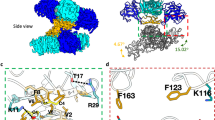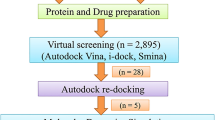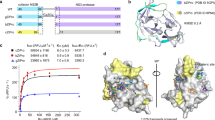Abstract
Recent outbreaks of Zika virus (ZIKV) highlight an urgent need for therapeutics. The protease complex NS2B-NS3 plays essential roles during flaviviral polyprotein processing, and thus represents an attractive drug target. Here, we developed a split luciferase complementation-based high-throughput screening assay to identify orthosteric inhibitors that directly target flavivirus NS2B-NS3 interactions. By screening a total of 2 816 approved and investigational drugs, we identified three potent candidates, temoporfin, niclosamide, and nitazoxanide, as flavivirus NS2B-NS3 interaction inhibitors with nanomolar potencies. Significantly, the most potent compound, temoporfin, not only inhibited ZIKV replication in human placental and neural progenitor cells, but also prevented ZIKV-induced viremia and mortality in mouse models. Structural docking suggests that temoporfin potentially binds NS3 pockets that hold critical NS2B residues, thus inhibiting flaviviral polyprotein processing in a non-competitive manner. As these drugs have already been approved for clinical use in other indications either in the USA or other countries, they represent promising and easily developed therapies for the management of infections by ZIKV and other flaviviruses.
Similar content being viewed by others
Log in or create a free account to read this content
Gain free access to this article, as well as selected content from this journal and more on nature.com
or
References
Calvet G, Aguiar RS, Melo AS, et al. Detection and sequencing of Zika virus from amniotic fluid of fetuses with microcephaly in Brazil: a case study. Lancet Infect Dis 2016; 16:653–660.
Chen LH, Hamer DH . Zika Virus: rapid spread in the western hemisphere. Ann Intern Med 2016; 164:613–615.
Govero J, Esakky P, Scheaffer SM, et al. Zika virus infection damages the testes in mice. Nature 2016; 540:438–442.
Ma W, Li S, Ma S, et al. Zika virus causes testis damage and leads to male infertility in mice. Cell 2016; 167:1511–1524.e15.
Miner JJ, Sene A, Richner JM, et al. Zika virus infection in mice causes panuveitis with shedding of virus in tears. Cell Rep 2016; 16:3208–3218.
Yepez JB, Murati FA, Pettito M, et al. Ophthalmic manifestations of congenital Zika syndrome in Colombia and Venezuela. JAMA Ophthalmol 2017; 135:440–445.
Thomas DL, Sharp TM, Torres J, et al. Local transmission of Zika virus - Puerto Rico, November 23, 2015-January 28, 2016. MMWR Morb Mortal Wkly Rep 2016; 65:154–158.
Martines RB, Bhatnagar J, Keating MK, et al. Notes from the field: evidence of Zika virus infection in brain and placental tissues from two congenitally infected newborns and two fetal losses - Brazil, 2015. MMWR Morb Mortal Wkly Rep 2016; 65:159–160.
Rodriguez-Morales AJ . Zika and microcephaly in Latin America: an emerging threat for pregnant travelers? Travel Med Infect Dis 2016; 14:5–6.
Baud D, Van Mieghem T, Musso D, Truttmann AC, Panchaud A, Vouga M . Clinical management of pregnant women exposed to Zika virus. Lancet Infect Dis 2016; 16:523.
Mecharles S, Herrmann C, Poullain P, et al. Acute myelitis due to Zika virus infection. Lancet 2016; 387:1481.
Carteaux G, Maquart M, Bedet A, et al. Zika virus associated with meningoencephalitis. N Engl J Med 2016; 374:1595–1596.
Chambers TJ, Grakoui A, Rice CM . Processing of the yellow fever virus nonstructural polyprotein: a catalytically active NS3 proteinase domain and NS2B are required for cleavages at dibasic sites. J Virol 1991; 65:6042–6050.
Falgout B, Pethel M, Zhang YM, Lai CJ . Both nonstructural proteins NS2B and NS3 are required for the proteolytic processing of dengue virus nonstructural proteins. J Virol 1991; 65:2467–2475.
Chappell KJ, Stoermer MJ, Fairlie DP, Young PR . Mutagenesis of the west Nile virus NS2B cofactor domain reveals two regions essential for protease activity. J Gen Virol 2008; 89:1010–1014.
Niyomrattanakit P, Winoyanuwattikun P, Chanprapaph S, Angsuthanasombat C, Panyim S, Katzenmeier G . Identification of residues in the dengue virus type 2 NS2B cofactor that are critical for NS3 protease activation. J Virol 2004; 78:13708–13716.
Zhang Z, Li Y, Loh YR, et al. Crystal structure of unlinked NS2B-NS3 protease from Zika virus. Science 2016; 354:1597–1600.
Phoo WW, Li Y, Zhang Z, et al. Structure of the NS2B-NS3 protease from Zika virus after self-cleavage. Nat Commun 2016; 7:13410.
Lei J, Hansen G, Nitsche C, Klein CD, Zhang L, Hilgenfeld R . Crystal structure of Zika virus NS2B-NS3 protease in complex with a boronate inhibitor. Science 2016; 353:503–505.
Chen X, Yang K, Wu C, et al. Mechanisms of activation and inhibition of Zika virus NS2B-NS3 protease. Cell Res 2016; 26:1260–1263.
Luo D, Vasudevan SG, Lescar J . The flavivirus NS2B-NS3 protease-helicase as a target for antiviral drug development. Antiviral Res 2015; 118:148–158.
Lim SP, Wang QY, Noble CG, et al. Ten years of dengue drug discovery: progress and prospects. Antiviral Res 2013; 100:500–519.
Sampath A, Padmanabhan R . Molecular targets for flavivirus drug discovery. Antiviral Res 2009; 81:6–15.
Brecher M, Zhang J, Li H . The flavivirus protease as a target for drug discovery. Virol Sin 2013; 28:326–336.
Pambudi S, Kawashita N, Phanthanawiboon S, et al. A small compound targeting the interaction between nonstructural proteins 2B and 3 inhibits dengue virus replication. Biochem Biophys Res Commun 2013; 440:393–398.
Bi K, Nishihara K, Machleidt T, et al. Identification of known drugs targeting the endoplasmic reticulum stress response. Anal Bioanal Chem 2015; 407:5343–5351.
Baell JB, Holloway GA . New substructure filters for removal of pan assay interference compounds (PAINS) from screening libraries and for their exclusion in bioassays. J Med Chem 2010; 53:2719–2740.
Wu CF, Wang SH, Sun CM, Hu ST, Syu WJ . Activation of dengue protease autocleavage at the NS2B-NS3 junction by recombinant NS3 and GST-NS2B fusion proteins. J Virol Methods 2003; 114:45–54.
Phong WY, Moreland NJ, Lim SP, Wen D, Paradkar PN, Vasudevan SG . Dengue protease activity: the structural integrity and interaction of NS2B with NS3 protease and its potential as a drug target. Biosci Rep 2011; 31:399–409.
Lorenz KJ, Maier H . Squamous cell carcinoma of the head and neck. Photodynamic therapy with Foscan. HNO 2008; 56:402–409.
O'Connor AE, Gallagher WM, Byrne AT . Porphyrin and nonporphyrin photosensitizers in oncology: preclinical and clinical advances in photodynamic therapy. Photochem Photobiol 2009; 85:1053–1074.
Tabata T, Petitt M, Puerta-Guardo H, et al. Zika virus targets different primary human placental cells, suggesting two routes for vertical transmission. Cell Host Microbe 2016; 20:155–166.
Tang H, Hammack C, Ogden SC, et al. Zika virus infects human cortical neural progenitors and attenuates their growth. Cell Stem Cell 2016; 18:587–590.
Zhang F, Hammack C, Ogden SC, et al. Molecular signatures associated with ZIKV exposure in human cortical neural progenitors. Nucleic Acids Res 2016.
Qian X, Nguyen HN, Song MM, et al. Brain-region-specific organoids using mini-bioreactors for modeling ZIKV exposure. Cell 2016; 165:1238–1254.
Garcez PP, Loiola EC, Madeiro da Costa R, et al. Zika virus impairs growth in human neurospheres and brain organoids. Science 2016; 352:816–818.
Green MD, Chen A, Nostro MC, et al. Generation of anterior foregut endoderm from human embryonic and induced pluripotent stem cells. Nat Biotechnol 2011; 29:267–272.
Chambers SM, Fasano CA, Papapetrou EP, Tomishima M, Sadelain M, Studer L . Highly efficient neural conversion of human ES and iPS cells by dual inhibition of SMAD signaling. Nat Biotechnol 2009; 27:275–280.
Zhang NN, Tian M, Deng YQ, et al. Characterization of the contemporary Zika virus in immunocompetent mice. Hum Vaccin Immunother 2016; 12:3107–3109.
Larocca RA, Abbink P, Peron JP, et al. Vaccine protection against Zika virus from Brazil. Nature 2016; 536:474–478.
Dai L, Song J, Lu X, et al. Structures of the Zika virus envelope protein and its complex with a flavivirus broadly protective antibody. Cell Host Microbe 2016; 19:696–704.
Lazear HM, Govero J, Smith AM, et al. A mouse model of Zika virus pathogenesis. Cell Host Microbe 2016; 19:720–730.
Noble CG, Seh CC, Chao AT, Shi PY . Ligand-bound structures of the dengue virus protease reveal the active conformation. J Virol 2012; 86:438–446.
Lei J, Hansen G, Nitsche C, Klein CD, Zhang L, Hilgenfeld R . Crystal structure of Zika virus NS2B-NS3 protease in complex with a boronate inhibitor. Science 2016; 353:503–505.
Small-Molecule Drug Discovery Suite 2016-3: Schrödinger Suite 2016-3, Schrödinger, LLC, New York, NY, 2016.
Nayal M, Honig B . On the nature of cavities on protein surfaces: application to the identification of drug-binding sites. Proteins 2006; 63:892–906.
Trott O, Olson AJ . AutoDock Vina: improving the speed and accuracy of docking with a new scoring function, efficient optimization, and multithreading. J Comput Chem 2010; 31:455–461.
Chambers TJ, Hahn CS, Galler R, Rice CM . Flavivirus genome organization, expression, and replication. Annu Rev Microbiol 1990; 44:649–688.
Triesscheijn M, Ruevekamp M, Out R, et al. The pharmacokinetic behavior of the photosensitizer meso-tetra-hydroxyphenyl-chlorin in mice and men. Cancer Chemother Pharmacol 2007; 60:113–122.
Glanzmann T, Hadjur C, Zellweger M, et al. Pharmacokinetics of tetra(m-hydroxyphenyl)chlorin in human plasma and individualized light dosimetry in photodynamic therapy. Photochem Photobiol 1998; 67:596–602.
Jurgeit A, McDowell R, Moese S, Meldrum E, Schwendener R, Greber UF . Niclosamide is a proton carrier and targets acidic endosomes with broad antiviral effects. PLoS Pathog 2012; 8:e1002976.
Rossignol JF . Nitazoxanide: a first-in-class broad-spectrum antiviral agent. Antiviral Res 2014; 110:94–103.
Fang J, Sun L, Peng G, et al. Identification of three antiviral inhibitors against Japanese encephalitis virus from library of pharmacologically active compounds 1280. PLoS One 2013; 8:e78425.
Shi Z, Wei J, Deng X, et al. Nitazoxanide inhibits the replication of Japanese encephalitis virus in cultured cells and in a mouse model. Virol J 2014; 11:10.
Xu M, Lee EM, Wen Z, et al. Identification of small-molecule inhibitors of Zika virus infection and induced neural cell death via a drug repurposing screen. Nat Med 2016; 22:1101–1107.
Krieger R. ed. Inhibitors and Uncouplers and Antiparasitic Agents. San Diego, CA: Academic Press, 2001.
Galan-Puchades MT, Fuentes MV, Mas-Coma S . Human Bertiella studeri in Spain, probably of African origin. Am J Trop Med Hyg 1997; 56:610–612.
Asnis D, Kazakov J, Toronjadze T, et al. Neurocysticercosis in the infant of a pregnant mother with a tapeworm. Am J Trop Med Hyg 2009; 81:449–451.
White CA Jr. Nitazoxanide: a new broad spectrum antiparasitic agent. Expert Rev Anti Infect Ther 2004; 2:43–49.
Rossignol JF, La Frazia S, Chiappa L, Ciucci A, Santoro MG . Thiazolides, a new class of anti-influenza molecules targeting viral hemagglutinin at the post-translational level. J Biol Chem 2009; 284:29798–29808.
ROMARK. Available from:.http://www.accessdata.fda.gov/drugsatfda_docs/label/2005/021818lbl.pdf
Balderas-Acata JI, Ríos-Rogríguez Bueno EP, Pérez-Becerril F, Espinosa-Martínez C, Burke-Fraga V, la Parra MG . Bioavailability of two oral-suspension formulations of a single dose of nitazoxanide 500 mg: an open-label, randomized-sequence, two-period crossover, comparison in healthy fasted mexican adult volunteers. J Bioequiv Availab 2011; 3:43–47.
Lessler J, Chaisson LH, Kucirka LM, et al. Assessing the global threat from Zika virus. Science 2016; 353:aaf8160.
Robbiani DF, Bozzacco L, Keeffe JR, et al. Recurrent potent human neutralizing antibodies to Zika virus in Brazil and Mexico. Cell 2017; 169:597–609.e11.
Murray KO, Gorchakov R, Carlson AR, et al. Prolonged detection of Zika virus in vaginal secretions and whole blood. Emerg Infect Dis 2017; 23:99–101.
Suy A, Sulleiro E, Rodo C, et al. Prolonged Zika virus viremia during pregnancy. N Engl J Med 2016; 375:2611–2613.
Hirsch AJ, Smith JL, Haese NN, et al. Zika virus infection of rhesus macaques leads to viral persistence in multiple tissues. PLoS Pathog 2017; 13:e1006219.
Barzon L, Pacenti M, Franchin E, et al. Infection dynamics in a traveller with persistent shedding of Zika virus RNA in semen for six months after returning from Haiti to Italy, January 2016. Euro Surveill 2016; 21:30316.
Inglese J, Auld DS, Jadhav A, et al. Quantitative high-throughput screening: a titration-based approach that efficiently identifies biological activities in large chemical libraries. Proc Natl Acad Sci USA 2006; 103:11473–11478.
Chen H, Liu L, Jones SA, et al. Selective inhibition of the west Nile virus methyltransferase by nucleoside analogs. Antiviral Res 2013; 97:232–239.
Chen H, Zhou B, Brecher M, et al. S-adenosyl-homocysteine is a weakly bound inhibitor for a flaviviral methyltransferase. PLoS One 2013; 8:e76900.
Zhang FC, Li XF, Deng YQ, Tong YG, Qin CF . Excretion of infectious Zika virus in urine. Lancet Infect Dis 2016; 16:641–642.
Deng YQ, Zhang NN, Li CF, et al. Adenosine analog NITD008 is a potent inhibitor of Zika virus. Open Forum Infect Dis 2016; 3:ofw175.
Sterling T, Irwin JJ . ZINC 15--ligand discovery for everyone. J Chem Inf Model 2015; 55:2324–2337.
Acknowledgements
We thank J Tang at the Wadsworth Center Tissue Culture Core facility for help in cell culture, E Eisele at the Biochemistry Core for assistance in CD experiments, and other core facilities at the Wadsworth Center, including the Applied Genomic Technologies Core for DNA sequencing, the Advanced Light Microscopy Core for immunofluorescence imaging, and the Tissue Culture Core for media. We also thank X Zhao at the University of Wisconsin-Madison for helpful discussion of neural progenitor cells. MB was partially supported by the NIH Biodefense and Emerging Infectious Disease training grant AI055429. CFQ was supported by the National Natural Science Foundation of China (NSFC) Excellent Young Scientist (81522025), Innovative Research Group (81621005), the National Key Research and Development Project of China (2016YFD0500304), the National Science and Technology Major Project of China (2017ZX09101005), and the Newton Advanced Fellowship from the UK Academy of Medical Sciences (NAF003\\1003) and the NSFC (81661130162). BL was partially supported by a visiting scholarship sponsored by Guangdong Ocean University. FG was partially supported by a visiting scholarship sponsored by the China Scholarship Council. This work was partially supported by the Wadsworth Center flavivirus drug discovery seed funding (HL, NB, and LDK), by NIH grant DA038446 (JZ), and by the Intramural Research Program of NCATS, NIH (MX).
Author information
Authors and Affiliations
Corresponding authors
Additional information
( Supplementary information is linked to the online version of the paper on the Cell Research website.)
Supplementary information
Supplementary information, Figure S1
Schematic diagram showing the firefly SLC strategy to monitor PPIs and principle tp screen inhibitors. (PDF 2897 kb)
Supplementary information, Figure S2
Gel filtration profiles for purifications of the MBP-NS3 (A), His-NS2B (B), and refolded His-NS3 (C), using a 16/60 Superdex S200 column with an AKTA purifier. (D) Transactivation of the MBP-NS3 and refolded His-NS3, by His-NS2B. (PDF 1516 kb)
Supplementary information, Figure S3
In vitro antiviral activity of Tempoporfin against ZIKV strain GZ0164 (PDF 836 kb)
Supplementary information, Figure S4
(A) The top-ranked site (gray surface presentation) for NS3pro (ribbon presentation) of DENV3 (PDB: 3U1I) from SiteMap calculation. (PDF 455 kb)
Supplementary information, Figure S5
Induced fit docking of drugs to the NS2B 2B51 and 2B53 pockets on NS3pro. (PDF 521 kb)
Supplementary information, Table S1
Primers used (PDF 340 kb)
Rights and permissions
About this article
Cite this article
Li, Z., Brecher, M., Deng, YQ. et al. Existing drugs as broad-spectrum and potent inhibitors for Zika virus by targeting NS2B-NS3 interaction. Cell Res 27, 1046–1064 (2017). https://doi.org/10.1038/cr.2017.88
Received:
Revised:
Accepted:
Published:
Issue date:
DOI: https://doi.org/10.1038/cr.2017.88
Keywords
This article is cited by
-
Advances in antiviral strategies targeting mosquito-borne viruses: cellular, viral, and immune-related approaches
Virology Journal (2025)
-
Medicinal chemistry insights of molecular docking and cell permeability mechanism of phytoconstituents present in Mimosa pudica as NS2B-NS3 protease inhibitors against dengue virus
Discover Chemistry (2025)
-
Exploring Niclosamide as a Multi-target Drug Against SARS-CoV-2: Molecular Dynamics Simulation Studies on Host and Viral Proteins
Molecular Biotechnology (2025)
-
Targeting west nile virus replication by xanthine inhibitors
Medicinal Chemistry Research (2025)
-
Kdm4a is an activity downregulated barrier to generate engrams for memory separation
Nature Communications (2024)



